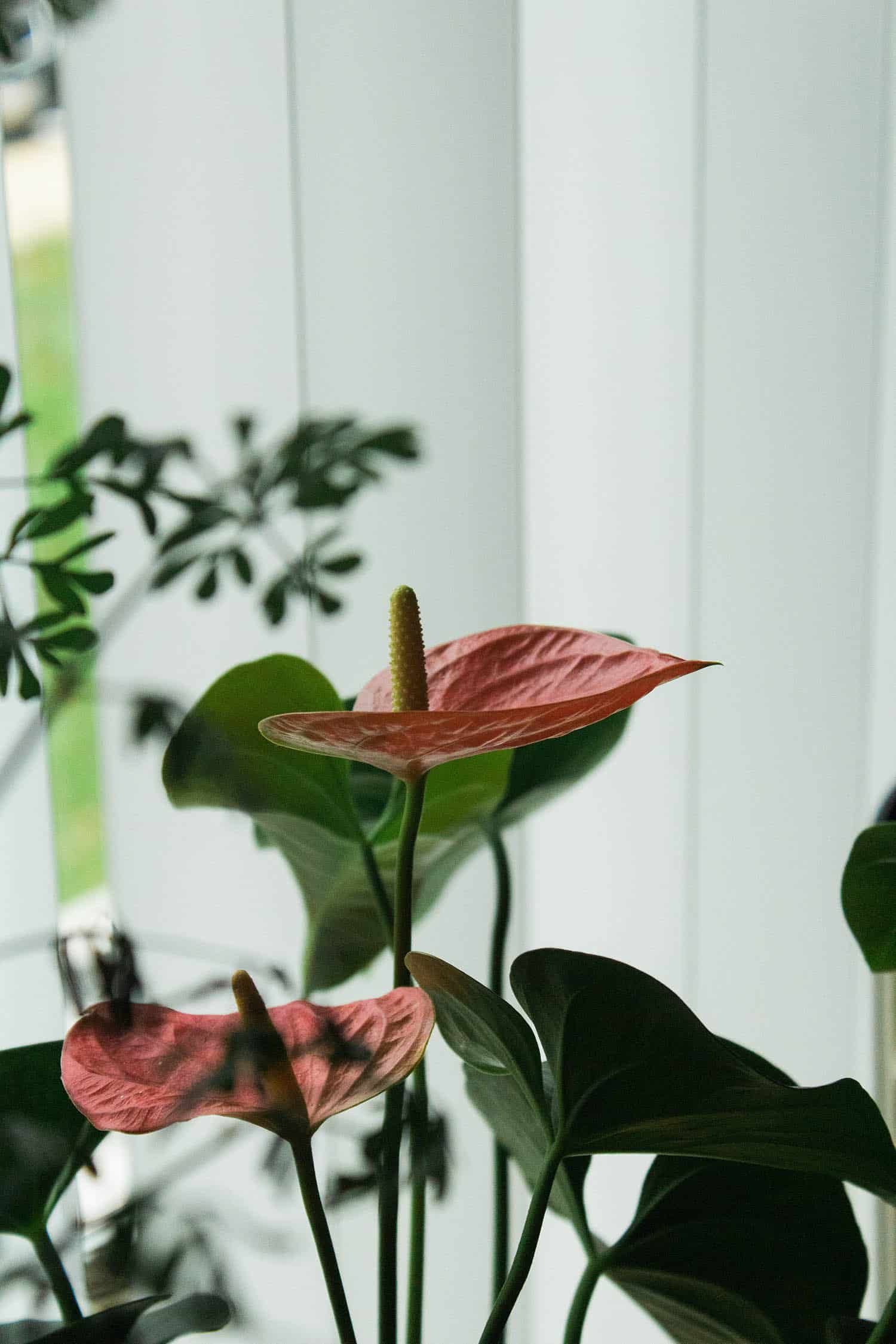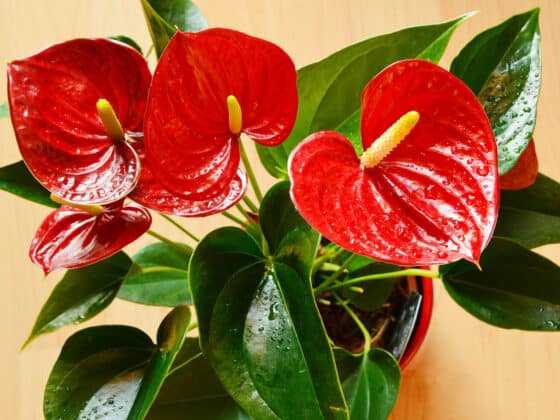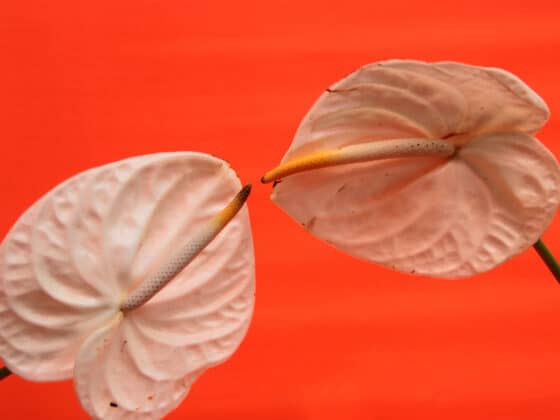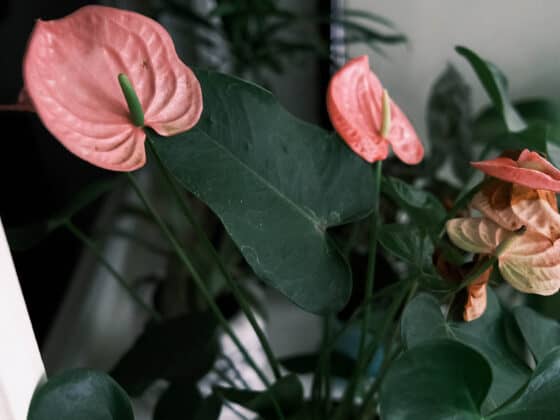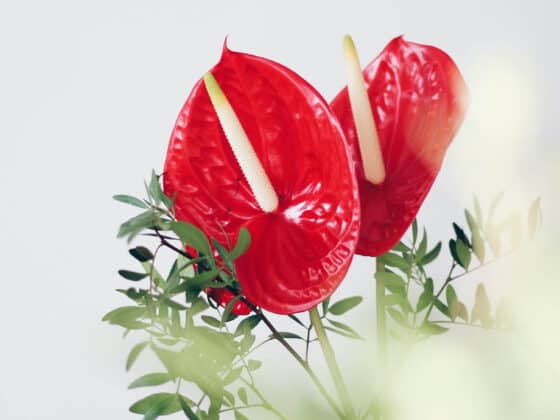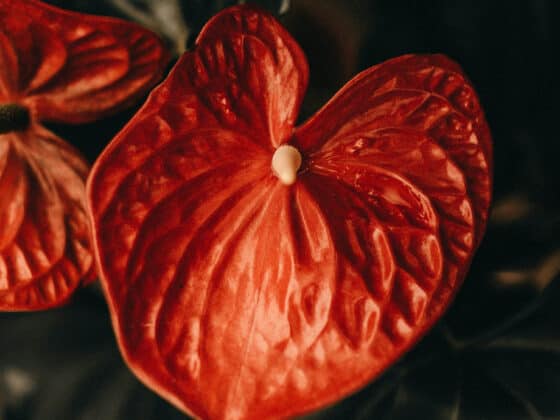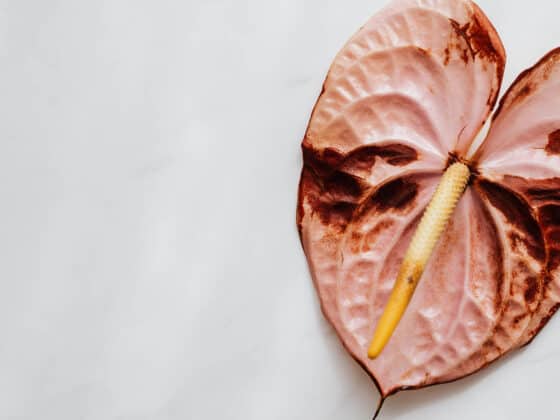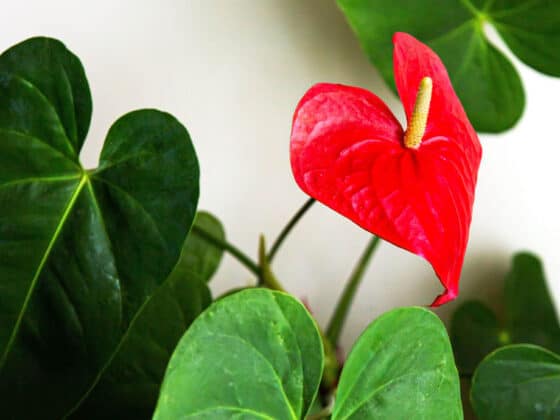Even at their happiest, Anthuriums aren’t lightning-fast growers, so it can be easy to forget about fertilizing them. But like most plants, they’ll be healthiest when they’re getting the right blend of nutrients to support their growth. So how should you feed your Flamingo Flower? What types of fertilizer are best for Anthuriums?
Give your Anthurium frequent, weak doses of fertilizer while it’s actively growing – for those in temperate climates, that means during the spring and summer months. If you value hefty blooms, use a fertilizer that’s higher in phosphorus to encourage flowering. Dilute it to ¼ strength and include it each time you water your Anthurium.
Over time, dissolved salts from fertilizers can build up in the soil and cause Anthurium roots to suffer. It’s a good idea to flush your plant’s container with water every few months if you’re giving it regular doses of fertilizer. Read on for more information about your Anthurium’s nutritional needs.
Does an Anthurium Need Fertilizer?
Most plants, especially slow-growing epiphytes like Flamingo Flowers, can survive for quite a while on just sunlight, water, and the carbon dioxide in the air.
But that’s sort of like saying that you could survive on oxygen, water, and quinoa. You might be able to avoid starving to death, but no nutritionist would recommend it. An Anthurium that’s not fertilized won’t grow or flower as enthusiastically as it would with the proper diet.
Many of the compounds that plants produce use additional chemicals beyond the carbon dioxide they absorb from the atmosphere. In nature, those elements are constantly accumulating in the soil, carried by then rain and the living things that die and decay into the earth. In an indoor container, however, it’s up to us to supply them.
If your Anthurium is planted in a store-bought potting mix, it should have enough nutrition to last it for six months to a year. Almost all commercially produced potting soil has some kind of fertilizer mixed in. But once your plant has sat in the same container for a while, you should think about supplementing its diet.
When To Fertilize Your Anthurium
Anthuriums are tropical plants, and in their native climate, they can grow all year round. However, if you live someplace that experiences winter, you’ll almost certainly see your Flamingo Flower go dormant during the colder months.
When the plant isn’t actively growing, there’s no need to give it any extra nutrition. In fact, you can actually damage the roots by adding more fertilizer than they can absorb. So stick to fertilizing in the spring and summer.
Nutrient deficiency in Anthuriums can be hard to spot – usually, the only indicator you get is that the plant isn’t growing during the warm season or isn’t flowering as much.
Both of these issues can also result from inadequate lighting, so check to see if your plant is getting enough sun before you consider boosting its fertilizer regimen.
Another possible sign of malnutrition is that your Anthurium’s leaves may become pale and faded. Once again, this can be caused by other factors – in this case, overheating. Make sure your Anthurium isn’t sitting in direct sun or in an area where temperatures exceed 90 degrees Fahrenheit. If this doesn’t fix the issue, the plant may need more fertilizer.
The Dangers of Over-Fertilizing Anthuriums
Less is more when it comes to adding fertilizer to your Flamingo Flower. As we’ve already mentioned, too little is unlikely to cause your plant serious harm. But too much can definitely damage it.
The nutrients in chemical fertilizers are supplied in the form of soluble salts. If you add more than your Anthurium can use, the excess will remain in the soil. At high concentrations, these salts can leach moisture out of the plant.
The results can look a lot like symptoms of underwatering: dried, withered leaves and stems, often with brown and crispy edges. If this goes on long enough, it can injure your Anthurium’s root system and put the plant’s life at risk.
Be warned: these symptoms could also point to root rot from overwatering. But if you’re certain you’re not giving the plant too much or too little water, then you may have a case of fertilizer burn on your hands.
Fixing Fertilizer Burn in Anthuriums
What do you do if you’ve over-fertilized your Anthurium? One option is to repot it, using fresh potting mix that isn’t packed with salts.
Of course, if the plant isn’t root-bound and still has room to grow, you may want a less drastic solution – not to mention one that requires less work and less mess.
In that case, you can try a soil flush. This basically means an extra-thorough watering to wash the built-up salts out of the pot. The technique is simple:
- Check whether there’s anything clogging the drainage holes of the container, such as roots or dirt clods. Clear any blockages out with the blunt end of a pencil or chopstick.
- Place the pot near an outdoor hose or in your tub or kitchen sink – basically anywhere that you don’t need to worry about lots of water pouring out.
- Run a slow, steady stream of water over the soil, but don’t let it overflow. Letting the water flow all the way out the base of the container is the whole point.
- Keep going until you’ve passed about four times the pot’s total volume through the soil.
- Let the container drain for a few hours before putting your Anthurium back in its usual spot. Place it on a drip tray because some water will continue to trickle through over the course of the next day or so.
- Empty the tray periodically so that your Anthurium’s pot isn’t sitting in standing water – that’s a recipe for root rot!
Even if you don’t see signs of over-fertilizing, it’s a good idea to flush your plant’s soil every few months as a preventative measure. Why wait until your Anthurium is already suffering?
What Kind of Fertilizer Do Anthuriums Need?
The first factor to look at when selecting a fertilizer is the nutrient balance. Plant supplements are categorized by their concentration of the big three macronutrients used by plants: nitrogen, phosphorus, and potassium.
This is represented by a sequence of numbers known as the NPK ratio, which comes from the symbols for these three elements in the periodic table. Nitrogen is always listed first, then phosphorus, then potassium.
Your Flamingo Flower needs some of all three, but most growers find that a fertilizer higher in phosphorus works best for these plants. This is especially true if you want your Anthurium to produce big blooms. Plants require plenty of phosphorus to produce flowers.
The ratio is more important than the absolute amount because you’re going to be diluting it down anyway. You’re looking for something with roughly a 1:2:1 ratio – an NPK value of 15-30-15 is a common choice.
You should also look for something that doesn’t contain much urea. This common form of nitrogen is great for plants that grow in the soil, but Anthuriums like to live the high life – they’re epiphytes that grow up the sides of taller plants, absorbing much of their nutrition from rainwater and tumbling leaves. So they can’t make much use of urea, and it can easily build up in the soil.
Fertilizers intended for orchids, a common epiphyte houseplant, will usually have a low urea content. So looking for high-phosphorus orchid food like this one is a good way to find fertilizer for your Anthurium.
Liquid vs. Pellet Fertilizers
There are basically two different kinds of synthetic fertilizers on the market. Some are sold as liquids, or powders intended to be dissolved in water. Others consist of small granules that you mix into the soil. Both of these options have strengths and weaknesses.
Granular fertilizers are generally designed to break down slowly, releasing nutrients a little at a time. They’re great for forgetful houseplant owners. You just add them to the pot once every six months or so to give your Anthurium’s diet a boost.
However, because granular fertilizers are slow-acting, they don’t work very well if you need to quickly revive a malnourished plant.
Liquid fertilizers require more frequent application, but they also offer more precision. It’s pretty simple to get precisely the correct dose by diluting the solution in a known volume of water. And the nutrients will hit your plant’s roots right away.
Our recommendation for Anthuriums is a liquid fertilizer. Flamingo Flowers live in trees and eat like birds, and even the slow leaching of nutrients from granular fertilizer can become too much for them over time.
Natural Fertilizers For Anthuriums
The advice above is specific to synthetic fertilizers, but lots of nature lovers prefer to go all-natural. What if you prefer to give your Anthurium the plant equivalent of ancient grains and wild-caught salmon?
Compost makes an excellent substitute for synthetic fertilizers. It’s derived from the same natural processes that create rich, loamy soil in nature. When wild Anthuriums grow in the ground instead of along tree trunks, they prefer soils rich in decayed organic matter. So feeding your plant compost will help it get back to its roots – so to speak.
You can add a layer of compost an inch or two thick to your Anthurium’s pot once or twice a year. This will provide benefits similar to those from a slow-release fertilizer. Compost usually isn’t as rich in nutrients as a synthetic formula, but that’s actually a good thing given the delicate appetites of Anthuriums.
As a bonus, mixing compost into your potting mix can improve its drainage. This is always a good idea for Anthuriums because they’re so susceptible to root rot. Good compost is light, fluffy, and full of air pockets, so it will help soil drain better. Aside from the ecological benefits, using compost is a lot less likely to result in fertilizer burn.
There is one important exception, however! Make sure that any compost you give your Anthurium is finished – in other words, that it’s gone through the full cycle of decomposition.
If your compost contains any clumps that are still in the process of breaking down, the chemical reactions in those chunks will actually absorb nitrogen from the soil. It’ll take nutrients away from your Anthurium instead of adding them. This should only be an issue if you’re making your own compost. Commercial composters are careful to sell only fully decomposed material.
If you’d like to read more about using compost to naturally fertilize your Anthurium houseplants, check out our article on the topic here.
Anthurium Nutrients From Rainwater
Another natural option is to collect rainwater and use that to water your Flamingo Flower. Collecting rainwater is actually the closest to the way Anthuriums get their nutrition in the great outdoors. The small trickle of organic matter and minerals in the rain will suit this finicky plant perfectly.
Of course, it can be hard to guarantee you’ll always have enough rainwater on hand. But if you live someplace with a decent amount of precipitation in the spring and summer, a good-sized rain barrel will go a long way.
How To Fertilize Anthuriums
We’ve covered a lot of options in the last few sections, and hopefully, you now have a better sense of your options for feeding your Anthurium. But if you’ve been skimming this article in search of a simple recommendation, look no further.
Our advice is to use a weak, liquid-based, synthetic fertilizer. This will allow you to provide the right balance of nutrients while diluting them enough to avoid over-fertilizing.
Another advantage is that the directions on the package will give you some guidance on how to apply it. But don’t follow the instructions exactly! Most commercial fertilizers recommend a dosage and frequency that will overwhelm delicate epiphytes like Flamingo Flowers.
Instead, take the recommended amount and mix it into four times as much water as the instructions call for. This will give you a ¼ strength dilution. Use this solution whenever you water your Anthurium during the growing season.
Weakly, Weekly?
Some houseplant fans recommend what’s known as the “weakly, weekly” method for Anthuriums, orchids, and other epiphytes. This method calls for even more frequent applications of an even lower dose – about 10-20% strength.
The basic idea behind this method is to mimic the slow trickle of nutrients that these air-rooted plants receive in the wild. But in the wild, Anthuriums aren’t in a container filled with potting mix – they’re rooted in rich loam or crawling up tree trunks. Which means they’re a lot less vulnerable to root rot than an indoor houseplant.
Unless you’re growing your Anthurium in an exceptionally fast-draining mix, placing it on a regular watering schedule puts it at risk for overwatering. You’re better off testing the soil every so often with a finger or a moisture probe. If the top inch or two of the soil has dried out, you can water it again.
For more on proper watering for Anthuriums and the dangers of root rot, take a look at our article on the subject.
Fertilizing Anthuriums By Misting
There is one way to apply the “weakly, weekly” method that works very well: instead of supplying nutrition through the roots, deliver it to the leaves in the form of a gentle spritz from a spray bottle. Think of it as molecular gastronomy for your Anthurium.
Flamingo Flowers are humidity-loving rainforest plants. They often find indoor air intolerably dry, especially in colder areas. So many growers give them a humidity boost by misting their foliage with a spray bottle at regular intervals.
Misting is an excellent delivery method for fertilizer, and it’s about as close as you can get to the way that your plant would receive its nutrition in nature. Simply add liquid fertilizer to your spray bottle until it’s at 10-20% strength compared to the instructions on the package.
This method won’t result in waterlogged soil, so a weekly application works fine. Lightly mist the solution over your Anthurium’s leaves and stems, and let it soak up the nutrients it needs.
One word of caution, however. If the water stays pooled on your Anthurium’s leaves for too long, it can lead to fungal growth. Keep an eye on the plant to make sure that the spray is evaporating. And if you see any sign of infection, trim away the diseased portions immediately and switch to a different method.
Final Thoughts
I hope you’re feeling more confident about how to ensure that your Anthurium has the nutrients it needs to produce big, shiny leaves and healthy, colorful blooms. The precision of liquid synthetic fertilizers will help you get the balance just right when you’re starting out.
But as you get more experience caring for your Anthurium, you may want to experiment with different methods. That’s great! There’s no substitute for practice as a houseplant grower.
Just remember that it’s a lot harder to remove extra fertilizer than to add a little more. So use low concentrations at first until you find the balance that makes your Flamingo Flower thrive.






